
Maintaining optimal oral health requires more than just daily brushing and flossing. Regular dental examinations play a crucial role in preventing potential health issues and ensuring long-term well-being. But how often should you really visit your dentist?
The Standard Bi-Annual Recommendation
Traditionally, dental professionals have advocated for check-ups every six months. This standard recommendation stems from several key considerations:
- Comprehensive oral health assessment
- Professional teeth cleaning
- Early detection of potential dental issues
- Preventive care strategy
Personalized Dental Examination Frequency
While bi-annual visits work for many, individual needs vary significantly. Several factors influence the ideal examination frequency:
Age-Related Considerations
- Children: Twice-yearly check-ups to monitor dental development
- Teenagers: Annual to bi-annual examinations
- Adults: Personalized frequency based on oral health status
- Seniors: Potentially more frequent monitoring
Health Risk Factors
Certain individuals may require more frequent dental examinations:
- Diabetes Patients
- Higher risk of periodontal disease
- Recommended quarterly check-ups
- Close monitoring of oral health indicators
- Smokers
- Increased risk of oral cancer
- Greater likelihood of gum disease
- Suggested 3-4 month intervals between examinations
- Pregnant Women
- Hormonal changes affect oral health
- Increased risk of gingivitis
- Recommended more frequent professional cleanings
- Individuals with Compromised Immune Systems
- Higher susceptibility to infections
- More vulnerable to oral health complications
- Potentially need more frequent professional assessments
What Happens During a Dental Examination?
A comprehensive dental exam typically includes:
- Thorough teeth and gum inspection
- Professional cleaning
- X-ray imaging
- Oral cancer screening
- Assessment of existing dental work
- Identification of potential health risks
Cost and Insurance Considerations
- Most dental insurance plans cover bi-annual check-ups
- Additional visits might incur out-of-pocket expenses
- Preventive care can reduce long-term dental treatment costs
Advanced Diagnostic Technologies
Modern dental examinations leverage cutting-edge technologies:
- 3D imaging techniques
- Digital X-rays
- Advanced screening protocols
- Comprehensive health assessment tools
Warning Signs You Need More Frequent Check-ups
Watch for these indicators suggesting more regular dental visits:
- Persistent bad breath
- Bleeding or swollen gums
- Tooth sensitivity
- Frequent dry mouth
- History of rapid dental issues
- Chronic medical conditions
Developing Your Personal Dental Care Strategy
Steps to Determine Ideal Examination Frequency
- Consult with your dentist
- Review personal health history
- Assess current oral health status
- Consider lifestyle factors
- Develop a tailored examination schedule
Economic and Health Benefits
Regular dental examinations offer significant advantages:
- Early disease detection
- Reduced long-term medical expenses
- Comprehensive health monitoring
- Preventive care approach
Conclusion: Proactive Oral Health Management
Your dental examination frequency should be a personalized decision. While bi-annual check-ups remain a solid baseline, individual health factors can necessitate more or less frequent visits.
Collaborate with dental professionals to develop a strategy that ensures optimal oral and overall health. Remember, prevention is always more cost-effective and less painful than treatment.
